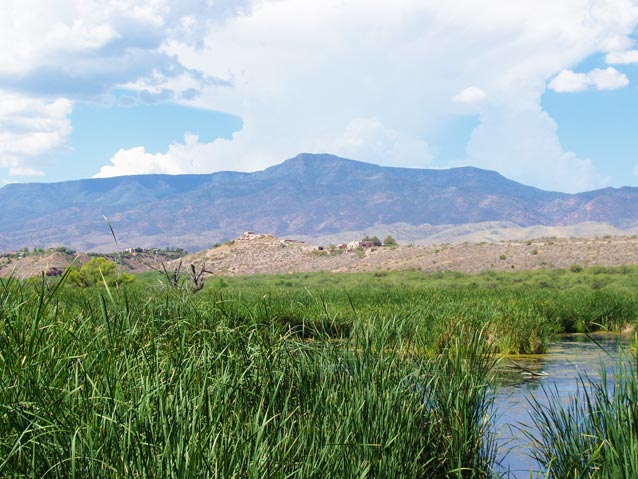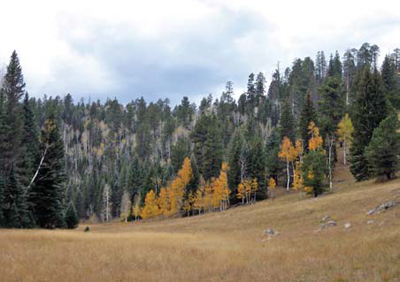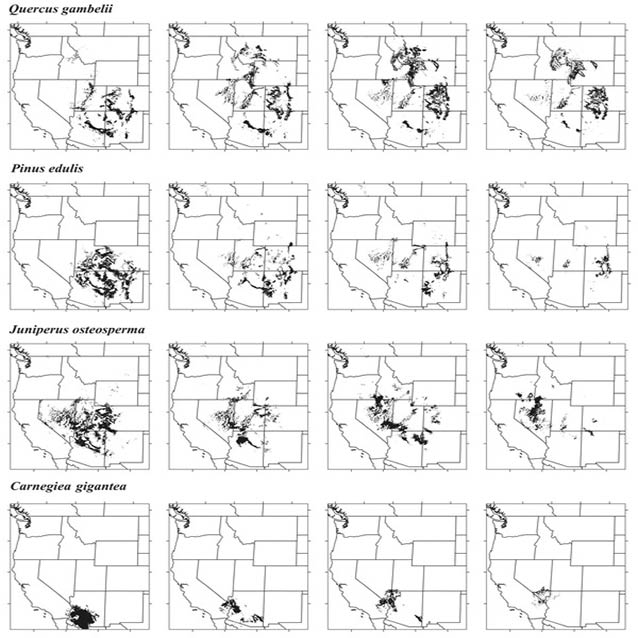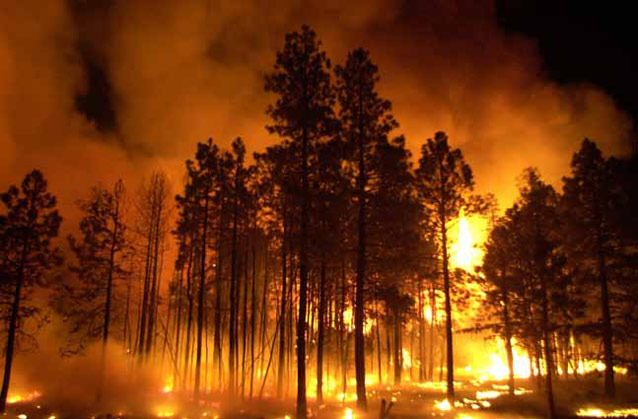In the Southwest, climate change may impact a variety of resources, including water availability in the form of snowpack and spring streamflow, the distribution and composition of plant communities, and fire regimes.
Climate change in the Southwest
The global rise in temperatures will affect different locations on earth in unique ways. Scientists have identified the Southwest as a climate change hotspot—an area whose climate is particularly vulnerable to an increase in greenhouse gases in the atmosphere (Diffenbaugh et al. 2008). The models used by the US Global Change Research Program indicate that the average annual temperature in the Southwest may increase by 4 to 10 degrees Fahrenheit, compared to temperatures between 1960 and 1979. Atmospheric circulation patterns are likely to change, causing southwestern climate to become more arid overall (Christensen et al. 2007, Seager et al. 2007). The aridity may become much worse during La Niña events, causing droughts that may be more severe than any other droughts seen in the climate record, including the medieval megadroughts (Seager et al. 2007, Dominguez et al. 2009). The Southwest may also experience more frequent and longer-lasting heat waves, and the precipitation that does fall is more likely to come from extreme precipitation events (Diffenbaugh et al. 2005). Human- caused changes in winter climate appear to be happening already: over the past 50 years, natural climate variability alone could account for only 40% of the changes observed in snow pack, winter air temperatures, and spring streams in the West (Barnett et al. 2008). These results indicate that if humans continue to emit greenhouse gases, future climate will continue to be outside the normal range of variability.
The seasonality and variability of the precipitation is likely to shift, too. Because of the effect of greenhouse gas emissions on climate, spring has been arriving earlier over the past 50 years, and this trend is likely to continue (Bonfils et al. 2008, Cayan et al. 2001, Stewart et al. 2004). The dry spring season is expected to begin earlier in the year because models predict that the late-winter storm track over the western United States may weaken and shift northward (McAfee and Russell 2008, Seager et al. 2007). If the dry-season is lengthened, severe droughts may occur more often. Drought effects could be amplified by increased variation in year-to-year winter precipitation. Although this variability has not yet been modeled for the future, it has been analyzed for the past 40 years. The analysis found that extreme reversals in winter precipitation from year to year have increased since 1960 (Goodrich and Ellis 2008). For example, the winter of 2004/2005 was the wettest winter on record, but the winter the following year was the driest winter on record. Winter precipitation is far easier to predict than monsoon precipitation because winter storms are large and follow storm tracks, but the monsoon storms are localized and their occurrence is influenced by topography. Therefore, current climate models cannot accurately predict the effect of climate change on the monsoon (Lenart 2007).
Potential climate change impacts

Water
Snowpack is a critical source of water in the Southwest, slowly releasing melted snow to streams and rivers over the dry spring and summer. The impact of climate change on snowpack and spring streamflow in the Southwest appears to be distinct from the rest of the western United States. While the rest of the West has been experiencing reduced snowpack, more winter precipitation in the form of rain, and earlier spring stream flows over the past 50 years, the Southwest has been experiencing the opposite (Knowles et al. 2006, Mote at el. 2005, Regonda et al. 2005). And while models using climate data from the past 50 years predict that spring snow melt in the West will occur even earlier than it does at present, they also predict that some streams in the Southwest will run later in the season than they currently do (Stewart et al. 2004). However, the climate over the past 50 years was influenced by a shift to a positive phase of the Pacific Decadal Oscillation in 1977. This shift would have enhanced winter precipitation over the Southwest relative to the drought years of the 1950s, especially during El Niño years, and reduced winter precipitation over the rest of the West. The clear delineation in climate patterns in recent decades between the northern half of the West and the Southwest is an indication of an El Niño influenced climate (Regonda et al. 2005). Because other models predict drier winters and earlier springs for the Southwest (McAfee and Russell 2008, Seager et al. 2007), the current trends in winter climate might reverse.
The rivers, streams, springs, wetlands, reservoirs, and lakes of the Southwest are sensitive to changes in the timing, amount, and predictability of precipitation. For the streams, a small change in average annual precipitation can greatly affect the surface flow. If late winter or spring moisture falls as rain rather than snow, catastrophic flooding could occur and the snowpack would be removed earlier, which would increase the susceptibility of these streams to extreme drying later in the year. While the aquatic communities are already disturbance prone and very resilient, larger-scale changes in the geomorphology of the stream channels, like arroyo-cutting, would have profound consequences for ecosystem structure and functioning. For the lakes, playas, and wetlands, changes in evaporation rates would alter electrolyte concentrations and chemistry. Also, decreased runoff would eliminate the ephemeral lakes and spring pools that are so important for supporting a diversity of animals and plants in the desert (Grimm et al. 1997). Warmer water temperatures and increased salinization may increase the likelihood that nonnative aquatic species will invade (Rahel and Olden 2008).

Vegetation
Vegetation shifts
Because water is the most limiting resource in arid ecosystems, even subtle changes in precipitation could lead to species migrations and re-shuffling of plant communities. For example, severe droughts can very swiftly shift the composition of a forest. During the 1950s drought, massive vegetation die-offs occurred over a variety of ecosystems in the Southwest (Swetnam and Betancourt 1998), and researchers have documented that pinyon-juniper woodlands at one site in the Jemez Mountains, New Mexico, completely converted to a ponderosa pine forest over a distance of 1.2 miles (Allen and Breshears 1998). This vegetation shift has endured for 40 years. The 2002-2003 drought, which was warmer than the 1950s drought, combined with a subsequent attack by bark beetles, caused extensive mortality of pinyon pines over 7,500 mi2 across the Southwest, even on moister high-elevation sites (Breshears et al. 2005). Over the entire western United States, mortality rates of overstory trees have been increasing in 87% of unmanaged forest plots, and these mortality rates are expected to double in 29 years for forests in the interior West (van Mantgem et al. 2009). Regional warming and consequent drought stress are the most likely explanations for why the trees are dying (van Mantgem et al. 2009). However, tree mortality can also occur during wet periods: although bark beetle outbreaks occur during droughts, spruce budworm outbreaks occur during wet conditions (Swetnam and Betancourt 1998).
Not only does the total amount of precipitation over a year influence plant communities, but when the precipitation falls affects them, too. In much of the Southwest, the balance between winter and monsoonal precipitation determines whether perennial grasses or woody vegetation predominates. For example, at a site in the Chihuahuan Desert in southeastern Arizona, increases in winter precipitation correlated with shrub expansion into grasslands (Brown et al. 1997). Future changes in the seasonality of precipitation can be expected to alter the composition of plant communities.
Warming, regardless of precipitation changes, can also affect plant communities. In montane ecosystems, warming is expected to cause plant species to shift upwards in elevation. In southern California, this shift is already happening. Between 1977 and 2007, dominant plant species in the Santa Rosa Mountains shifted upwards in elevation by about 65 m (Kelly and Goulden 2008). Warming may also affect the distribution of desert plants because of their sensitivity to freezing. Since the lower boundary of the Sonoran desert may be where freezes never happen and the upper boundary may be where freezes last less than 24 hours, warming temperatures would allow thorny shrubs and scrub trees from further south to establish in the current boundaries of the Sonoran desert, and the Sonoran desert would expand northward, eastward, and upward in elevation (Weiss and Overpeck 2005). From 1960 to 2000, the number of days below freezing has already decreased (Weiss and Overpeck 2005).

(from Rehfeldt et al. 2006)
Over a larger scale, these subtle impacts to plant communities may cause extensive changes, both to the distribution of whole plant communities and to individual species. One study modeled the future distributions of vegetation in the West if unmitigated climate change continues (Rehfeldt et al. 2006). The study found that over the current century, grasslands and montane forests would increase, largely at the expense of arid woodlands, and subalpine, alpine, and tundra communities. The whole plant communities would not migrate together; instead, the range shift of each species would be unique. Of the nine species studied, Gambel oak (Quercus gambelii) would increase in area, and the area occupied by Douglas-fir (Pseudotsuga menziesii) would remain constant, but the other species, notably western larch (Larix occidentalis), pinyon pine (Pinus edulis), Engelmann spruce (Picea engelmannii), and Utah juniper (Juniperus osteosperma), would decrease drastically in area. The species’ ranges would shift both in elevation and in latitude and longitude. For example, the range of the saguaro cactus (Carnegiea gigantea) is projected to rise in elevation by 2000 ft and to shift northward by 310 miles, so that its range will shift to southern Nevada. By the end of this century, approximately 55% of the western landscape would experience climates incompatible with the vegetation located there today. Therefore, the plant communities in these areas would have no contemporary analogue in the region, and it would be impossible to predict the exact composition and distribution of future plant assemblages over the West (Rehfeldt et al. 2006).

Photo courtesy of the Arizona Emergency Information Network
Fire
The interaction between climate and fire may further alter vegetation communities. The effect that climate change will have on fire regimes strongly depends on the vegetation type—fires in particular vegetation types can be limited by fuel moisture or fuel availability, or both. For example, spruce-fir forests, which are relatively wet forests, naturally experience infrequent, high-severity fires, usually during drought. Therefore a shift to more arid conditions would result in more severe fires (Schoennagel et al. 2004). The fire severity in mixed conifer forests, which typically occur along a complex moisture gradient on elevations between spruce-fir forests and ponderosa pine forests, is controlled by both climate and fuel availability. Drier conditions would result in a mosiac of fire effects on the landscape, where the fire regimes of the wetter sections of the forests would be more influenced by extended drought (Schoennagel et al. 2004). Ponderosa pine forests, which are typically drier and occur at lower elevations than spruce-fir and mixed conifer forests, historically experienced frequent, low-intensity fires that were limited by the availability of fine fuels. However, 20th century fire suppression has resulted in increased tree density; therefore, the fires that occur are high severity, stand-replacing fires (Schoennagel et al. 2004). The fire regimes in pinyon-juniper woodlands are not as well studied as the fire regimes in higher elevation plant communities. Large, stand-replacing fires in pinyon-juniper woodlands have been occurring more frequently since the 1980s, but not enough evidence on historical fire regimes exists to determine whether this increase in large fires is due to climate (Romme 2009). While the recent increased frequency of large wildfires across the West is associated with earlier spring snowmelts or spring or summer temperatures, this is not the case in the Southwest, likely because extended drought is not the only influence on severe fires in the major forest types of the region (Westerling et al. 2006).
The effect that climate change will have on fire regime will also depend upon the climate variability from year to year. In the past, climate variability has influenced the outbreak of fires across the Southwest. From analyzing the fire scars in tree-ring records spread over Arizona and New Mexico, researchers have found that synchronous fires across the regions have occurred multiple times, and these fire years coincide with drought, or, in the case of open ponderosa pine forests, a wet year followed by a dry one (Swetnam and Betancourt 1998). Analyses of more recent fires have uncovered the same pattern—in ponderosa pine forests, and in dry shrublands and grasslands, wet conditions in the years prior to the fire year influence the fire severity more than drought conditions in the year of the fire (Littell et al. 2009,Westerling et al. 2003). The reason may be that during the wet years, fine fuels accumulate (Swetnam and Betancourt 1998). Unlike in spruce-fir forests, fires in ponderosa pine forests and in grasslands feed off of fine fuels, like grasses and needle litter. These studies of fire history in the Southwest indicate that a warmer and drier climate may not necessarily cause more severe fires; instead the effect that climate has on individual fire regimes will depend upon the vegetation type, the overall aridity, the interannual variability of precipitation, the seasonality of the precipitation, and how the forests are managed.
Impacts by Region
Climate Change and the Chihuahuan Desert
Climate Change in the Sonoran Desert
Part of a series of articles titled Climate Change in the Southwest.
Last updated: August 14, 2017
